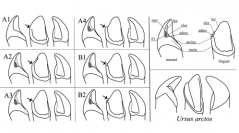

 Comptes Rendus Palevol
18 (2) - Pages 209-222
Comptes Rendus Palevol
18 (2) - Pages 209-222Morphometric and morphotypic variability of the cave bear upper incisors from two different geographic regions (Caucasus and Urals), different stratigraphic periods (middle and late Pleistocene), and bearing different mitochondrial haplogroups (kudarensis and ingressus) was studied. The specific diet of the cave bears, i.e. hard vegetables, led to noticeable differences between their incisors and the incisors of the brown bear (Ursus arctos ). It was found that the upper incisors of the Caucasian cave bears from different stratigraphic periods demonstrate consistent development of their morphology. The late Pleistocene cave bears from the Urals show a greater similarity to the Caucasian cave bears from earlier periods than with the cave bears from later periods. Our results suggest that the incisor morphology has evolved independently in the Caucasian and Ural cave bears as they belong to different phylogenetic lineages and display different ways of adaptation to local environmental conditions.
Ursus, Cave bears, Morphotypes, Size, Variations, Incisor, Evolution, Pleistocene, Caucasus, Ural